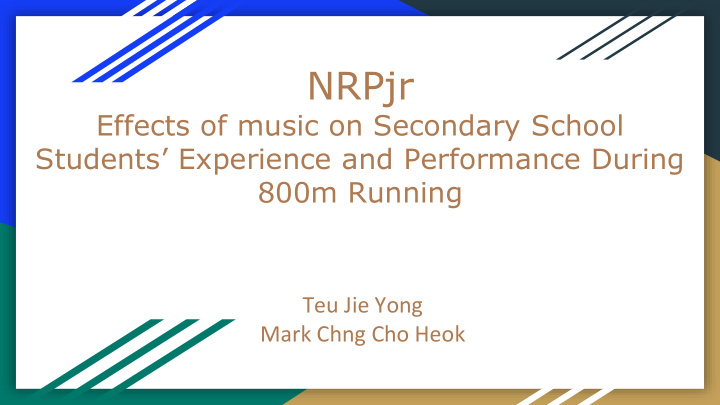



NRPjr Effects of music on Secondary School Students’ Experience and Performance During 800m Running Teu Jie Yong Mark Chng Cho Heok
Refine School Fitness Programmes (eg. NAPFA, PE Lessons)
Cultivate Exercise Habits Since Young
● Regulate emotions and moods ● Induce enjoyable state ● Promote rhythmic movement ● Develop ergogenic effect (enhance physical performance)
Asynchronous music Synchronous music ● ● 120 to 140 bpm No specific bpm ● ● Enhances mood Improve exercise performance ● ● Hinders feeling of pain and fatigue Rhythmic aspects of music allows body movements to sync with ● Does not encourage music synchronisation of body movements and music
Aims and Objectives ● Effects on attentional focus and running enjoyment ● Attain similar study results as caucasians
Research question With the application of music to the students’ run, will there will be a significant effect on the students’ attentional focus and their enjoyment experiences?
Dissociation Association
Research Literature ● Females benefit more from the effects of music [1] ● Participants in the most preferred music condition were shown to have the highest levels of dissociation [2] ● The tempo and volume of the music affects a person’s dissociation and association processes [3]
Hypothesis ● Synchronous music can better aid in the runner’s dissociation process during their run compared to asynchronous music ● Music benefit female youths tremendously, enhancing their running experience through increase of heart rate and enjoyment levels, compared to males
Methodology and Procedure ● Music selection ● Lab tests (15 Females 11 Males) ● Attentional Focus Scale (AFS) ● Interest/Enjoyment scale survey ● Heart rate monitor
Lab test procedure ● 3 music playlists consist of no music, synchronous music and asynchronous music condition ● Music volume is controlled ● Double-blind experiment
Lab test procedure 1. Participants use Brunel Music Rating Inventory-3 to select preferred music with different motivational music qualities 2. Run warm up of 2 minutes on treadmill with warm up playlist and rest 5 minutes after 3. Start running 800m on treadmill with music playlist 1 and rest for 10 minutes after 4. Participants have their heart rate measured, rate AFS and Enjoyment survey 5. Participants to repeat step 3 to 4 with music playlist 2 and music playlist 3
Heart Rate Sensor
Results and Discussions
Table 1 - Highest AF observed in the Asynchronous Music condition - Lowest AF observed in the No Music condition - The AF scores in the three conditions were not different between females and males. - This result indicates that AF scores were not significant across the music conditions.
Discussion ● No significant interaction effect between asynchronous music and synchronous music ● Results were not significant between genders ● Data does not support hypothesis
Table 2 - Highest HR observed in the Asynchronous Music condition - Lowest HR observed in the No Music condition. - The main effect of the genders was not significant Post hoc tests - There were significant HR differences between No Music and Asynchronous Music conditions (p = .002), and between No Music and Synchronous Music (p = .02) HRs between Asynchronous Music and Synchronous Music conditions were not significantly different (p = .35)
Table 3 - Highest enjoyment level observed in the Asynchronous Music condition - Lowest enjoyment level for the entire sample was observed in the No Music condition. - Enjoyment levels were significantly different across the music conditions. - The main effect of genders was not significant such that enjoyment levels in the three conditions were not different between females and males. Post hoc tests- There were significant enjoyment level differences between No music and Asynchronous Music conditions (p = .001), and between No music and Synchronous Music conditions (p = .003). Enjoyment levels between Asynchronous Music and Synchronous Music conditions were not significantly different (p = 1.00).
Discussion ● Results not significant between genders ● Heart rate increase with music application ● Enjoyment levels increase with music application ● Data does not support hypothesis ● Music provides positive influences on runners
Possible flaws and errors ● Running pace was not fixed ● A lag in recording of results may cause the results to be inaccurate ● Small sample size
Conclusion ● Synchronous music does not provide greater positive experiences than asynchronous music Both genders benefit positively from music application ●
References [1]](Cole, Z., & Maeda, H. (2015). Effects of listening to preferential music on sex differences in endurance running performance. Perceptual and motor skills, 121(2), 390-398.) [2]Effects of music on enjoyment in exercise ( Allison K. Dyrlund, Steven R. Wininger) (Dyrlund, A. K., & Wininger, S. R. (2008). The effects of music preference and exercise intensity on psychological variables. Journal of music therapy, 45(2), 114-134.) [3] Copeland, B. L., & Franks, B. D. (1991,March)https://doi.org/10.1016/0167- 8760(95)00007-F
Special thanks to: Dr Masato Kawabata & Miss Bern for their patient guidance throughout this one year, fellow NRP researchers that have helped us along the way, and finally to participants and everyone else that has helped us in this project in one way or another.
THANK YOU
Males
Females
More recommend